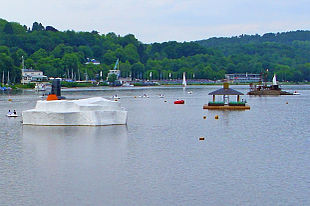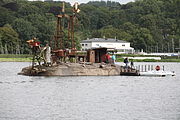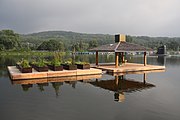Ruhr atoll
The Ruhr Atoll was an art project that could be seen from May to October 2010 on the Baldeneysee in Essen . It comprised four artificial islands that were installed on the lake, as well as the Ruhr Atoll Hall, in which the models of these and other designs for the project were exhibited. Originally called Folkwang Atoll , this was a project by the Gelsenkirchen concept artist Norbert Bauer, which was implemented as part of the RUHR.2010 project - European Capital of Culture .
The atoll islands
The four artificial islands of the Ruhr Atoll, three of which could be entered, could only be reached with pedal boats. The motto art is energy - energy is movement also applied to the visitors.
The Ruhr Atoll project was completed in October 2010. The island ICEBERG was not winter-proof and was demolished. The remaining three islands were then anchored in the port of the Ruhrverband in order to find buyers for them by spring 2011 and to recover an estimated six-figure deficit of the Ruhr.2010 project.
The submarine island with the inscription I can because I want what I have to is now in Duisburg's inner harbor in front of the Küppersmühle Museum as part of its permanent collection.
Project for the Conservation of Natural Resources
The Russian artist couple Ilya and Emilia Kabakov contributed the design "Project for the Conservation of Natural Resources". Rusty, squeaky and dripping mechanisms brought water out of the lake, transported it across the island through a so-called laboratory, and back into the lake. The work is a subtle ensemble for scientific work.
Frog and tea master
Two islands of the same size are connected by a footbridge. A solar-powered water pump fills a water tank in the center of the tea house, from where the water flows over the roof back into the lake and into the ten flower beds on the other island. Artist Kazuo Katase and architect Michael Wilkens dealt in this work with the basic needs of humans. This island was the only one that was not accessible to visitors.
ICE BERG
Artist Andreas Kaiser and polar explorer Lars Kindermann have designed an artificial iceberg. At the top of the ice is an orange tent that is illuminated at night. Buried inside is a container reminiscent of the PALAOA measuring station (Perennial Acoustic Observatory in the Atlantic Ocean) of the Alfred Wegener Institute . Four visitors at a time can enter the ICEBERG for a few minutes and hear natural sounds and visualized data from the Antarctic inside a container.
I can because I want what I have to.
The observation tower of a submarine protrudes out of the water, with the Kantian sentence I can because I want what I have to write on the outside walls . is cut out. The resulting 'windows' are filled with subject-related pictures in the form of slide material. The submarine tower is based on the nuclear-armed Ohio boat class of the US Navy. From the outside, the work of artist Andreas M. Kaufmann and media scientist Hans Ulrich Reck appears to be a destructive weapon, from the inside it looks like a chapel. During the day, the energy stored by solar cells on the rudders on the tower is fed by a lamp that illuminates the boat from the inside at night.
Proposals planned but not implemented
Marking time
The Maltese artist Norbert Francis Attard designed an apple carpet that was to float on the lake in a twelve by twelve meter wooden frame. The apple should represent human transience and denounce the affluent society both through its own symbolic power and through the onset of rot. This project generated heated discussions even without being implemented.
Local - global
Artist CU Frank's design of an oversized lifebuoy was to encompass the floating island below the weir on Lake Baldeney. Depending on the weather and water level, this island is sometimes visible, sometimes flooded. The design was not implemented as part of the project.
More artists
Originally 25 islands were planned. These designs also belong to the Ruhr Atoll. Among other things, they were not implemented for technical reasons. Designs came from Otto Piene , Jan van Munster , Joep van Lieshout , Stefan Sous, Nils-Udo , Ugo Dossi , Magdalena Jetelová , Winter / Hörbelt , Franz West , Rolf Hinterecker, Gereon Lepper , Heinrich Brummack and Rudolf Knubel.
The lens art group installed an action during the exhibition weeks against environmental pollution such as the oil spill in the Gulf of Mexico or local pollution. A canoe with four vulture dummies visited all four Ruhr atolls to interact with them, after which it moved to a location on the edge of the lake. The inscription on the side We have the oil corresponds to a sign on the bank And you the plague and several fake birds and fish. After consultation with the curators of the Ruhr Atoll artworks, the installation was viewed as a supplement.
Individual evidence
- ↑ Buyer wanted for Essen Ruhr Atoll. In: DerWesten.de. December 1, 2010, accessed October 17, 2013 .
- ↑ RWE foundation blog of October 14, 2013: Appeared: The “submarine” from the Ruhr Atoll is now in front of the Küppersmühle Museum ( memento of the original from October 23, 2013 in the Internet Archive ) Info: The archive link was automatically inserted and not yet checked. Please check the original and archive link according to the instructions and then remove this notice. ; Retrieved October 17, 2013
- ↑ Nourishing the Soul. In: DerWesten.de. June 4, 2010, accessed December 20, 2010 .
- ↑ Nature photographers: Ruhr Atoll was expanded from July 26, 2010
literature
- Information brochure on the Ruhr Atoll
- I. & E. Kabakov, A. Kaiser, K. Katase, AM Kaufmann: Das Ruhratoll . Ed .: Norbert Bauer. 1st edition. Klartext Verlag, Essen 2010, ISBN 978-3-8375-0489-7 .
- RWE AG (Ed.): Culture Electrifies . 1st edition. Klartext Verlag, Essen 2010, ISBN 978-3-8375-0260-2 .





